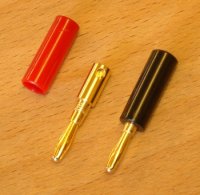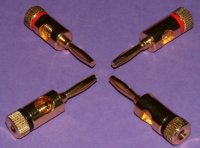|
RINGMAT OFC SPEAKER CABLE
|
At the time of writing, we offer just
one Speaker Cable, Ringmat OFC Pure
Power.
RINGMAT OFC PURE POWER SPEAKER CABLE
RINGMAT OFC PURE POWER is a sizeable
speaker cable with an outer diameter of
13mm. It is very flexible and the
interior mould of the outer jacket hugs
4 substantial conductors in position
around a central filler. Although the
cable can be used to bi-wire to 2 pairs
of terminals, it is designed for use as
a single run cable from one pair of
terminals to another pair, with the
‘opposite’ conductors paired. It also
sounds very much better that way. The
design of the cable is such that it has
very low capacitance and very low
resistance, resulting in exceptional
tonal performance and a transparent and
accurate sound reproduction. The sense
of power and space is awesome, and yet
resolution and fine nuances are
exquisitely presented.
|
|
|
|
Recommended further
reading...
|
|
|
|
|
|
 |
Inside the cable jacket the ridges that
hold the conductors in position are talc
lined, enabling the cores to adjust
position as the cable is wound and
handled, avoiding permanent twists and
knots. This also helps reduce vibration
internally and further enhances the
sound.
Conductor sheaths are colour coded.
Accordingly, cores north and south
(blue) should be joined together as,
say, positive, and cores east and west
(black) joined together as, say,
negative.
The cable is directional. Normally,
signal direction is the same as the
print on the cable, but the
manufacturers cannot warrant it. We
shall check it out each time there is a
production run.
TERMINATION
The Pure Power Speaker Cable is
available either in 3m or 5m stereo
pairs, terminated with various
connectors (see below), or off the reel.
On request, other lengths, terminated,
are also available. See our
price list.
For some systems, it may be sufficient
that the full 56 strands of the speaker
cable are used, as provided when
unterminated. When used in this manner,
the cable has the additional merit of
smoothing over deficiencies in many
systems.
However, when the number of strands has
been reduced from 56 to 49, the clarity
and other aspects of sound quality are
transformed. When the cable is provided
terminated, this reduction in the number
of strands has already been done.
The insulation of the Cable is quite
easy to cut with a sharp blade, rather
like hard cheese, and full guidance is
either given at point of sale or,
perhaps where the sale is not direct
through Ringmat Developments,
subsequently on request.
The terminated strands at the end of
each conductor should not be soldered to
any connector or plug. Use of solder not
only destroys the benefit of removing
the 7 strands, it also limits the
overall performance of the cable.
PLUGS AND CONNECTORS
Where the speaker terminal sockets are
sufficiently substantial to take the
paired conductors, it is obviously
better to connect in this way rather
than use connector plugs. However, the
thickness of the paired conductors of
the Pure Power Cable is often too great
for direct insertion into most speaker
cable sockets. It is then necessary to
use plug connectors to clamp onto the
bare wire cores and for the pins of the
connectors to be inserted into the
speaker cable sockets.
The design of the plug connectors used
with the Pure Power Cable is very
important, which is why we have chosen
to use either our selected UK made 4mm
stackable banana plugs or the WBT
Insulated 4mm banana plugs (also
stackable) or 8mm spades when the Cable
is provided terminated. All other plugs
we have tried have degraded the sound.
Our selected UK made 4mm stackable
banana plugs are not insulated,
therefore it is important to ensure at
all times that they do not touch one
another or other conductive objects
whilst connected to an amplifier which
has not settled after being turned off,
or has not been muted in accordance with
the manufacturer’s instructions. |
|
Terminal plates - ugh! It has become the
practice of some speaker manufacturers
to provide pretty gold coloured plates
to connect same polarity speaker sockets
where making provision for the single
wiring of bi or tri-wirable speakers.
These plates destroy the sound and
should be replaced with speaker wire
similar to that used for carrying the
signal from the amplifier to the speaker
(assuming this cable is found to be
satisfactory). Whilst this is a general
point, in practice we would expect our
Pure Power Speaker Cable to be used!
USEFUL HINTS FOR USERS
In general, it is usual to connect the
positive (red) conductors/connectors to
the red speaker cable sockets at both
ends and the negative (black)
conductors/connectors to the black
speaker cable sockets. However, there
are two reasons why this may not be the
best way.
1.
Some speakers have certain of their drive units
out of absolute phase to the other drive units.
We find this arrangement damages the sound, and
so where separate terminal sockets are provided
at the rear of the speakers for each drive unit,
it may be desirable, in respect of those drive
units out of polarity with the others, to
reverse the connections. In such cases, connect
the positive (red) conductors/connectors to the
black speaker cable sockets at the speaker end
and the negative (black) conductors/connectors
to the red speaker cable sockets. Treat both
speakers the same.
2. To accurately reproduce recorded
sound, the absolute phase of the signal
to the speakers should be the same as
that used for the recording or embedded
in the software (record, disc, tape,
etc.) The absolute phase of the
recording can either be at 0° or 180°,
and will vary between tracks and at
edits. The same problem exists with
broadcast sound. To obtain most pleasure
from your music, it may be necessary to
invert the phase of the signal to your
speakers to match that used for the
recording, in which case reverse the
polarity of the connections for each
pair of terminals at the back of both
speakers. Before you do so, however,
first ensure that the (power) amplifier
is switched off and allowed to settle,
or its output muted, in accordance with
the manufacturer’s instructions. How do
|


|
you
know which is the correct absolute phase to use?
The only way to find out is to listen, both with
and without the absolute phase being inverted.
Stick with that which is the more musical and
where the detail of the image is the most
defined and focused. We have interesting
developments to report on this subject, which we
shall publish in due course. When our Remote
Controlled Absolute Phase Inverter is available,
this will make the whole business much easier
with the sound on a very much higher plane.
Remember, when listening after a change of
cables or of any equipment, allow some time
before the transfer of the signal, and therefore
the sound, settles down. It should start to
improve after half an hour and will be better
after two hours, but will improve still further
after a few days. The same applies each time the
system is switched on, though the time taken
will usually be less when no changes have been
made, depending upon how long the equipment has
been left turned off.
Another aspect affecting the sound when changing
cables or equipment is the change in the
‘loading’ of the system. Not enough is yet known
about this ‘loading’ factor, but it appears to
have a great deal to do with the timing of the
signal and the timing of sound reflections.
Inevitably, this affects the timing of the
music, which can suddenly seem to go flat after
a change in the system. These tiny changes in
the timing of sound reflections can also give
rise to what might otherwise be thought to be
distortion, and can be found throughout the
frequency range. It is, however, possible to
accommodate most of these changes in timing by
adjusting the distance the speakers are placed
from the rear wall and the extent to which the
speakers are ‘toed-in’. |